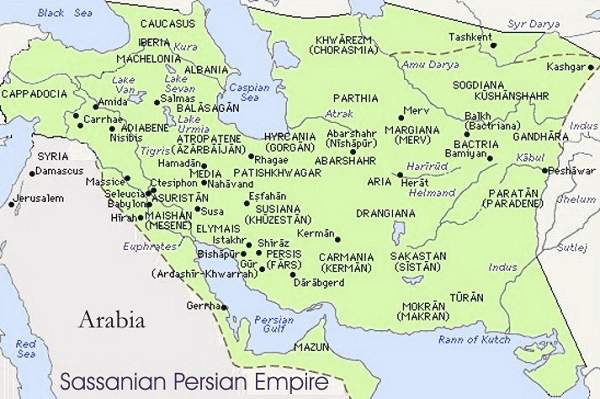Volume One
Ancient and Medieval States
Background
Confederate Empires

Parthian Empire
The Parthians or Arsacids (247 BC – 224 AD) occupied the eastern realms of the former Achaemenid Empire (550-330 BC) {1} that had become the Seleucid Hellenistic kingdom (312-63 BC) {2} after the Alexander conquest. Parthia was a natural entity, extending from the Caspian Sea to the Persian Gulf and reaching almost to the Mediterranean. Today this vast area is largely one of deserts and inhospitable mountains, but the land was more fertile two millennia ago, and held many flourishing cities, often built in the style of the Greek city state.
The Parthians have suffered from a bad press. Their war-like qualities have been emphasized by Roman sources, particularly the arrow-shooting skills of the light cavalry and their heavy cataphracts. The Parthian Empire was a decentralised administration, certainly, with satrapies enjoying sufficient independance to issue their own coins on occasion, but the empire was not a disorganised rabble of wild tribesmen. Little has survived the subsequent Sasanian takeover and the Arab conquests, but these scattered remains point to a cultivated people building on a rich and multicultural inheritance.
What little is known of the Parthians comes from outside sources, supplemented by rock inscriptions, scattered cuneiform tablets and, most importantly, their coinage. {3} The earlier coins — drachmas and tetradrachms, and just possibly some presentation gold pieces — were modelled on Greek lines and indeed employed Greek legends on their reverses. In the last coins of the empire, this Greek has degenerated into meaningless decoration supplemented by good Aramaic, i.e. the empire had thrown off its Greek heritance and reverted to its original Achaemanid roots.{5}
Art, architecture, religious beliefs and royal insignia suggest the Parthian state was a varied mixture of Persian, Hellenistic and local elements. There was no standing army, and power was somewhat decentralized. The Parthians ruled from Nisa and then Ctesiphon (south of modern Baghdad), but also allowed semi-independent satraps to form at the fringes of the empire, largely outside what is Iran today. In the west the Parthians were opposed by the Seleucids, from whom they had seized territory, and in the east were threatened by the newly-arrived Yueh Chih, the tribal peoples who were to form the Kushan Empire. As the Parthians expanded westwards they came into conflict the Kingdom of Armenia, and then the late Roman Republic. After the Parthians annihilated the large army of Crassus at the Battle of Carrhae in 53 BC, they expanded into the Levant, but could not hold these territories against Roman forces, and indeed the Romans captured the cities of Seleucia and Ctesiphon on several occasions. {3-4}
Mithridates II
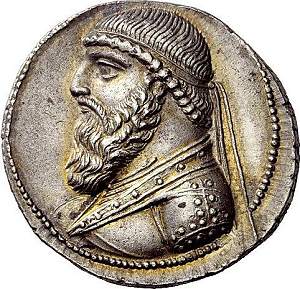 | Under Mithridates II (121-91 BC), the Parthian Empire reached its greatest extent under Mithrades the Great, who came to the throne at a perilous time, when the Parthians were suffering military defeats in the east and west, but not only restored order, but took Armenia and extended Parthian rule to the Euphrates. Most threatening were the Yueh Chih tribesmen in the east, who had destroyed the Indo-Greek kingdoms and were advancing on Parthian lands. Yet Mithridates reconquered lost territories, and even wrested Seistan from these central Asian peoples that would eventually form the Kushan Empire. Towards the end of his reign, Mithridates faced a rebellion from his nephew, which was put down by Gotarzes I, son and successor to Mithidrates. {6} |
Greek coins, Parthia, Mithradates II, 129 – 88, Tetradrachm, Seleukia c. 129-88, AR 15.64 g. Obverse: diademed bust of Mithradates l. | Mithridates II also restructed the admnistration of the empire, and replaced the Babylonian styles of temples by more Hellenic/Parthian ones. {6} |
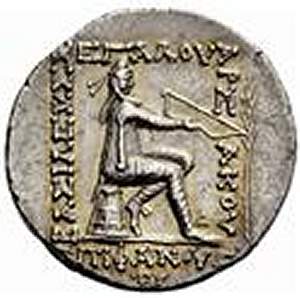 | The Parthians are remembered most for their military skills. Horsed archers could shoot accurately in all directions, giving rise to the 'Parthian shot'. The main fighting force, led by the aristocracy, was the cataphract, however: heavily-mailed cavalry that was rightly feared by the Romans. In fact, though they originated as wild tribesmen from central Asia, the Parthians soon became a civilised people, adopting some of the Macedonian and then Roman customs, though not in marriage. Parthian kings could marry their neices or even half-sisters. In one isolated case, Queen Musa in fact married her son. {6} |
Reverse. BASILEWS – MEGALOU - APSAKOU Parthian archer seated r. on omphalos, holding bow; in outer r. field, palm branch. In exergue, EPIFANOYS / TV. (Shore 67. Sellwood 24.4.). | Parthia was by no means an isolated backwater. The first tribesmen used Greek on their coins, which indeed look like those of the Seleucids and Indo-Greeks. The country was always part of international trade routes, moreover, connecting Rome with China, and bringing new ideas, customs and material goods. {3-4} |
Development of the Parthian Coinage
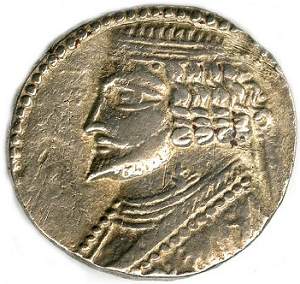 | 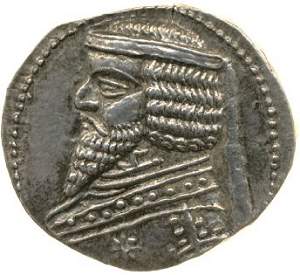 | 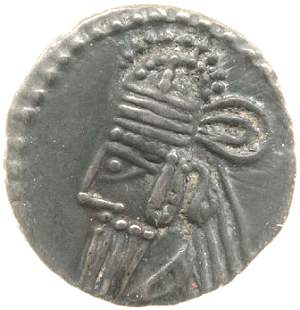 |
 | 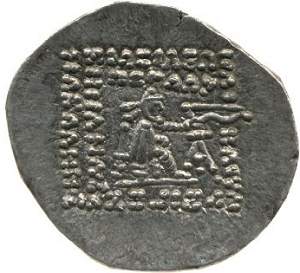 | 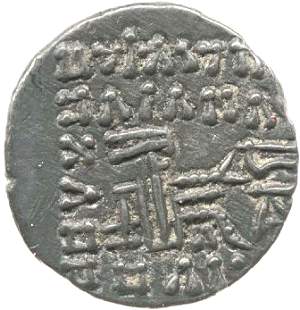 |
Parthia. Ar tetradrachm. Phraates IV (38-2 BC) 12.33 g. 28 mm. 35 BC Obverse: Short-bearded Phraates IV facing left, wearing diadem and torque, and with a wart on his brow. Dotted border.Reverse: ΒΑΣΙΛ[ΕΩΣ] ΒΑΣΙΛΕΩ[N] ΑΡΣΑΚΟΥ ΕΥΕΡΓΕΤΟΥ ΔΙΚΑΙΟΥ [E]ΠIΦΑNΟΥΣ [ΦΙ]ΛΕΛΛΗΝΟΣ (BASILEOS BASILEON EUERGETOU ARSAKOU DIKAIOU EPIPHANOUS PHILELLENOS Seleucid year 278 (35 BC) : Of the King of Kings Arsaces, Benefactor, Just, God Manifest, Philhellene) HOC ΠANH (EOS PANE: Syrian year 278) {3} | Parthia. Ar Drachm. Phraates III. (70 BC-57 BC) 4.12 g 20.5 mm. Obverse: Bearded Phraates left, wearing diadem and torque ending in seahorse. Dotted border. Reverse: Archer seated on throne right. Square legend around ΒΑΣΙΛΕΩΣ ΜΕΓΑΛΟΥ ΑΡΣΑΚΟΥ ΕΥΕΡΓΕΤΟΥ ΕΠΙΦΑΝΟΥΣ ΦΙΛΕΛΛΗΝΟΣ (BASILEOS MEGALOU ARSAKOU EUERGETOU EPIPHANOUS PHILELLENOS: Of Great King Arsaces, Benefactor, God Manifest, Philhellene) Minted Ecbatana . BMC Greek (Parthia) 2, p.45 Sellwood 1980 38.3 | Parthia. Osroes II (190 AD) Ar drachm. 3.67 g. 18 mm. Obverse: long-bearded Osroes II facing left, wearing tiara with pelleted crest, ear flaps and segmented necklet. |
For most of its duration, the Parthian Empire issued coins in the Hellenistic or Indo-Greek fashion. Tetradrachms were struck occasionally, with some base metal issues, but the bulk of Parthian coinage is in silver drachms. The king appears on the obverse, realistically modelled in the round, and the reverse bears an inscription in good Greek arranged on four sides around a central figure, usually the seated figure of a Parthian archer, but sometimes a Greek god or local goddess. {4} In the last century of its existence, when it suffers inroads from Roman legions, and some civil wars, the Greek degenerates into meaningless letters and dots, though this 'decoration' is sometimes supplemented by a line of good Aramaic. Such Aramaic lines appear on the coins of Mithradates IV (c. 140 AD), Vologases IV (147-208 AD) Vologases V (191-208 AD), Osroes II (c. 190 AD) and of Artbanus IV (216-224 AD). Greek-style portraits also become more schematic in time, a process mirroring charges from Indo-Greek to Kushan coinage. Why so? What was the purpose of maintaining a blundered Greek legend on coin reverses when no one could read it?
Probably because it provided continuity with the past: the same denomination was appearing with much the same weights, purities and designs. Perhaps Greek die cutters were also employed in the early Parthian Empire, and though these skills became scarcer in troubled times, something approaching the earlier coinage was still needed. In a similar fashion, the coins of the Crusader kingdoms imitating well-made Islamic issues often employed blundered Islamic legends, which gave them legitimacy in the kingdoms concerned and acceptability to infidel mercenaries, but not to Muslim states, where the legends had religious significance.
Since coins rarely contained the full metal content of their face value, most issues were to some extent a fiat coinage. But whereas the Crusader pieces passed muster by their contained silver alone, Islamic pieces needed more, a legitimacy, something issued by a rightful ruler who invoked God's blessing on his reign. Similarly, the late Parthian coins may have had legitimacy within the borders of the empire, but have been valued by their silver content only when they were shipped further afield, to Rome sometimes, but more probably eastwards to China.
Aramaic
Aramaic is an ancient Semitic language, and it was an Aramaic dialect of the Assyrians that became the lingua franca of the Near East from the eighth century BC onwards, to be eventually adopted by the Achaemenid or Persian Empire. Coins were struck in this language, for town commerce and army payments, and Alexander the Great continued the practice a little at first, before issuing the great floods of Greek silver needed to pay his mercenaries. Shortly afterwards, when the lands of Alexander's conquest became Hellenistic kingdoms (here the Seleucids), the administration, language and coinage also became Greek, and it was these Greek customs that the Parthians adopted to rule the lands they had seized. {10} But no doubt the Aramaic continued in the speech of local people, and this Aramaic rose to official acceptance again when Greek customs died out in the last century of Parthian rule. A conquered people gradually assimilating their rulers is a common feature of empires: witness the gradual return to original (Greek) roots in the eastern Roman Empire, Jin Tartars (to Chinese), Norman England (to Anglo Saxon customs), Ilkhanid Persia (to Islam).
Between Two Worlds
The Parthian kingdom was a successful fusion of nomadic and sedentary ways of life, and, unlike many such fusions (e.g. Mongol Persia and China), largely remained so. Until the last years of Parthian rule, the older civilisation (Achaemenid and Seleucid) seems not to have assimilated the new. The kingdom certainly continued the monetised society of the Seleucids but preserved the fighting abilities of the Aparni steppe warrior by rigidly dividing society into two classes. To the lower class belonged peasants and townsmen. To the aristocracy belonged the Aparni 'freemen', who practised horse riding and warfare. The two-fold division into cataphracts and the horse-archers was also of steppe origin. Contacts were maintained with the nomads of middle Asia and the Caspian-Pontic steppes, moreover, notably through alliances and political marriages. {11}
Sasanian Empire: Dinar of Bahram I
Sasanian Empire
The Sasanian empire was created around 224 AD when Ardashir I, a descendant of Sasan, convincingly defeated the Parthians. Under Shapur I (241-272 AD) the central government was strengthened, the coinage reformed, and Zoroastrianism made the state religion. In the pomp and splendour of their kings, the Sasanians saw themselves as the successors of the Achaemenid Persians, and their expanding territories quickly brought them into conflict with Rome. In a battle near Edessa in 260 AD, the emperor Valerian was captured, treated shamefully and died in captivity. The Romans indeed found the centralised Sasanian Empire a more serious foe than the earlier Parthians, and were largely obliged to leave their eastern border at Palmyra, a caravan city in Syria. By the end of Shapur I's reign, the Sasanian empire stretched from the Euphrates to the Indus and included modern-day Armenia and Georgia. Territories were lost under succeeding rulers, but restored by Shapur II (309-379 AD), who re-established control over the Kushans in the east and campaigned in the desert against the Arabs.{18-21}
Fluctuating Fortunes
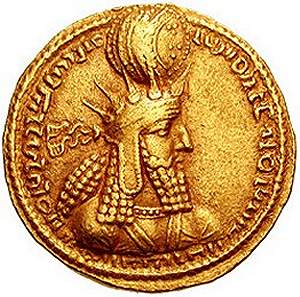 | Wars with Rome saw Sasanian control again exerted in northern Mesopotamia and Armenia. In the fifth century, the Sasanians came into conflict with the Hephthalite (white) Huns, who had created an extensive tribal empire centred on Afghanistan. The Sasanians were initially forced to pay tribute to the Huns, but recovered independence under Khosrow I (531-79 A.D), who defeated this menacing threat. Later wars of succession, and with the Byzantine Empire, weakened the Sasanians, however, and Arab armies united under Islam defeated them in 642 AD. The last Sasanian ruler, Yazdegerd III, died in 651. {18-22} |
Bahram I. 273-276 AD. Au Dinar. Weight 7.39 gm. Obverse: Crowned and cuirassed bust right. Legend: MaZDaYaSN BaGI VaRaHRAN MALKAN Malka AIRAN MiNUVhaTRI MiN YaZDAN Wa ANAiRAN (The Mazda worshipper, the divine Bahram, the king of kings of Iran and non-Iran who is descended from the Gods) in crude Pahlavi. | The Parthians may have struck gold coins — the evidence is fragmentary and disputed {6} — but the succeeding Sasanian dynasty did indeed mint a handsome series of dinars and multiple dinars for prestige and probably presentation purposes. {24.26, 29} |
 | Sasanian rulers can be identified by their individual crown shapes, {27} but for the other details the legends have to be deciphered.. The script is Pahlavi, a form of Aramaic, read from right to left, but where a Semitic alphabet has been forced to serve an Indo-European tongue,(as it would again in Persian). {11} |
Reverse: Fire altar with attendants; taurus symbol to right of flames. Legend:NURA ZI VaRaHRAN ('Fire of Bahram' in crude Pahlavi right and left) Göbi I/1; cf. Paruck 105; Alram 705. | The short vowels are left out. Some Semitic words are still written in their Semitic form, particularly the numerals. Letter shapes are often ambiguous, and scribes sometimes wrote one letter when they meant another. All this makes Sasanian coins difficult to read, though the Sasanian dynasty is well documented: events, rulers and their reign periods. {11} |
Religion
As to be expected in countries forming the great silk route, many religions were practised in the area appropriated by the Sasanians.{30-31} The state religion was Zoroastrianism, however, one of the world's most ancient religions and, as to be expected in a regime aiming to recapture its early splendour, was the religion of the earlier Achaemenid Empire. Zoroastrians worship the one God (Ahura Mazda) and believe fire represents God's light or wisdom, revealed to them by the Prophet, Zoroaster. Prayer takes place several times a day in a fire temple or Agiary, an image of which typically appears on the reverses of their coins, in great detail on their earlier issues.{32-33}
Manichaeism originated in Sasanian Persia in the person of Mani, a nobleman of good standing who tried to synthesize a new religion from the best aspects of pre-existing religions, His views were entertained seriously by Ardeshir I, who was keen to adopt whatever means he could find to assert his authority, but less so by Bahram I, whose concerns centred more on religious and social uniformity within the Sasanian empire. Mani was tried, executed and made a public exhibition of in the Sasanian manner, his flayed body body afterwards being stuffed with straw (as was that of the captured Roman emperor Valarian) as a warning to all.{34-35}
However sensible or innocuous it might seem, Manichaeism was seen as a major heresy, one denounced by established religions of the time, but still collecting millions of followers. Manichæism was a religious dualism, the clash of good with evil, and the doctrine grew rapidly, maintaining its hold in the middle east until the second millennium, but spreading west as far as France and Africa and east to northern India, western China, and Tibet to an uncertain date. With that dualism came asceticism, a stress on sexual purity, and an acute sense of a world-wide mission. Women were especially attracted to the religion, which awarded them more equal status.Mani was unusual, however, in writing the tenets himself, rather than trusting his disciples to hand them down correctly {34-36}
Mani was seen by his followers to be one of the divinely inspired prophets that included Zoroaster, the Buddha, Jesus Christ (and later Muhammad and Bahá'u'lláh) sent out into the world to rescue the true message from the corruptions of the times. Manichaeism arose in a highly cosmopolitan culture, in full awareness of antecedent west Asian religions such as Zoroastrianism, Christianity, and various pagan and Gnostic sects, as well as the Hindu, Jain, and Buddhist traditions of south Asia. Zoroastrianism is also dualist, but Manichaeism was closer to Indian thought in seeing souls not only in human beings, but in all things, even inanimate matter. That soul, moreover, is a collective entity, an emanation of the deity, broken into individuals only temporarily through their admixture of evil. Human beings are only one small part of a universal process of struggle and liberation of the world soul, a soul that carries with it all positive properties, such as life, growth, beauty, and brightness, and where evil contributes to the mixture only death, decay, ugliness, and gloom. Zoroastrians seek to expel evil from the world, but Manichaeans see the world as unperfectable, a temporary scene of conflict and suffering from which, like Buddhists, we escape through understanding. In its various ramifications, Manichaeism had a wide influence on Asian thought, notably the Gnostic strains of Sufism and Shi'ism. {36}
Manichaeism
Why the opposition? It was not merely denounced as heresy, but its adherents hunted down and extirpated — in the Persian Empire, the Roman world, Tang China, the Abbasids and in medieval France. St. Augustine himself was a lapsed Manichaean, who repented afterwards with:
'I still thought that it is not we who sin but some other nature that sins within us. It flattered my pride to think that I incurred no guilt and, when I did wrong, not to confess it... I preferred to excuse myself and blame this unknown thing which was in me but was not part of me. The truth, of course, was that it was all my own self, and my own impiety had divided me against myself. My sin was all the more incurable because I did not think myself a sinner.' (Confessions, Book V, Section 10)
At this point we might anticipate the discussion on depth psychology (Mughal India) and note the suffering believers of different faiths inflict on each other by taking psychological perspectives as literally true. Why shouldn't the human soul be a battleground of good and evil, or light and darkness? Because we deny God His purpose, or larger dimension? Other religions are not as faith or scripture based as Christianity or Judaism, and Buddhists do not recognize a God at all.
Because it recognised a power of darkness equal to the power of good, and was thus subversive to states claiming an authority blessed by God or the Heavens. Even theological disputes between Catholics and Protestants threatened the authority displayed on coinage, as the French Wars of Religion illustrate. Henry IV had to convert to Catholicism, and the Treaty of Westphalia, which inaugurated the modern state, laid down the principle of a state religion.
References and Further Reading
Need the 37 references and 7 illustration sources? Please consider the inexpensive ebook.

